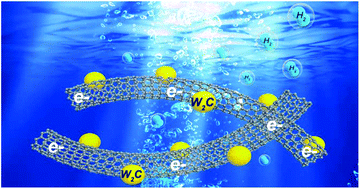W2C nanodot-decorated CNT networks as a highly efficient and stable electrocatalyst for hydrogen evolution in acidic and alkaline media†
Abstract
Although tungsten carbide (W2C) has long been reported as an excellent platinum-like catalyst, it is still a challenge to synthesize W2C as an electrocatalyst for a highly efficient hydrogen evolution reaction (HER) due to its high onset overpotential, inevitable aggregation, and lack of a scalable and controllable synthesis method. Herein, we synthesized W2C nanodot-decorated CNT networks (W2C@CNT-S) via a facile and scalable spray drying method followed by a carbonization process. It is demonstrated that this unique nanoarchitecture, constructed by ultrafine W2C nanodots homogeneously decorated on a three-dimensional and conductive CNT skeleton, leads to the exposure of abundant catalytic sites and promotes highly efficient electron transfer and ion diffusion during the HER process. As a result, in acidic and alkaline media, the optimized W2C@CNT-S hybrid exhibited excellent HER performance with very low onset overpotentials of only 60 and 40 mV (vs. RHE) and very small Tafel slopes of 57.4 and 56.2 mV dec−1, and only needed 176 and 148 mV (vs. RHE) to obtain a current density of 10 mA cm−2, respectively; it also showed outstanding long-term durability even after a 30-hour test in both acidic and alkaline media. This study presents an overview of a low-cost and scalable spray-drying strategy to synthesize a high-performance carbide-based electrocatalyst for hydrogen evolution.

- This article is part of the themed collection: Nanoscale Most Popular Articles


 Please wait while we load your content...
Please wait while we load your content...